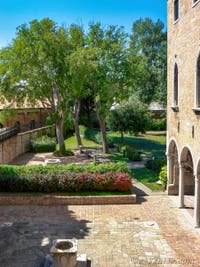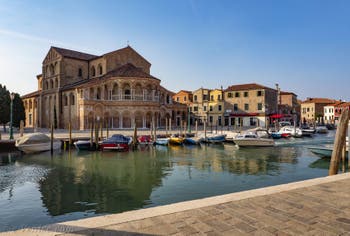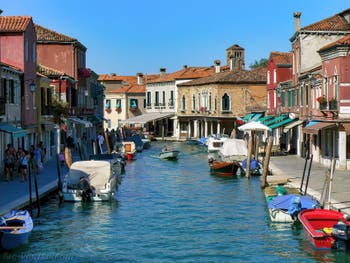The island of Murano, home of glass, pleasures and gardens
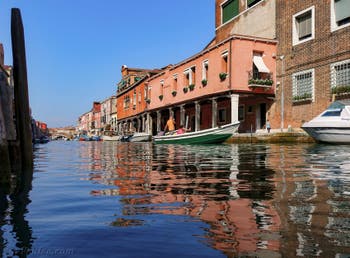
The Rio dei Vetrai in Murano Just a 10-minute vaporetto ride from Venice, a walk on the island of Murano is a great idea if you're staying in Venice.
Going to Murano gives you a taste of the Venice lagoon and its sumptuous stretches of water.
If the island of Murano is visited today it is above all for its glassworks, which developed there intensively after a decree by the Senate in 1201.
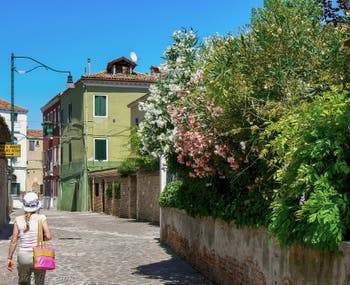
Oleanders on the island of Murano But Murano was also the island of gardens, where the Aretines and the famous Venetian printer, Alduce Manuce, liked to relax with his friends.
Is it because of its gentle gardens? Is it because of the softness of its gardens, the intoxicating scent of its jasmine flowers and its orange groves that Murano has also become the island of naughty pleasures?
No one knows, but the fact remains that the island's "light" reputation reached new heights in the 18th century with its famous convents of nuns more excited by the pleasures of this world than by celestial emotions.
So not only were there palaces, but also the famous casins, including the famous Murano casin of the French ambassador, the future Cardinal de Bernis.
It was here that Casanova would meet up with the nun M.M. and "play" with her while de Bernis enjoyed their lovemaking by watching through a secret peephole...
What is less well known is that Murano is also the setting for one of the main origins of fairy tales.
These are the famous "Pleasant Nights" otherwise known as "On the Moon" famous tales by Giovan Francesco Straparola.
The Italian origins of the fairy tale
Giovan Francesco Straparola published a collection of fourteen fairy tales, The Piacevoli Notti (The Pleasant Nights), in two volumes in 1550 and 1553.Straparola's Tales contain versified riddles with erotic overtones.
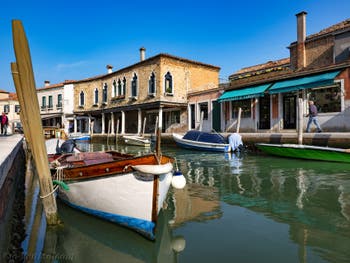
Rio dei Vetrai Fondamenta Manin But these fairy tales are also a fairly critical view of the power struggles within Venetian society.
The story takes place on the island of Murano. The Bishop of Lodi, Ottaviano Maria Sforza, is forced to flee Milan with his daughter, the pretty widow Lucretia. They both sought refuge first in Venice and then settled in a palace on the island of Murano.
There, they formed a family around them. A small court of ten graceful maidens, four gentlemen and two matrons formed around them.
Carnival is about to come to an end and Lucretia proposes that, until Lent, everyone will take their turn telling a story. Seventy-four fables will be told over thirteen nights.
Steeples like towers in a desert
“Murano and Torcello pointed their bell towers like towers emerging from a desert.
Birds whirled and smoke fled southward.
Still long russet streaks, heavy water and, the only animators of these spaces, stakes, to indicate passes, stakes with blackened heads, that gathered in bundles seemed like snakes biting at the sea.”
Jacques Adelswärd-Fersen - Our Lady of the Dead Seas 1902
The island of Murano in Venice, Vast Liquid Spaces
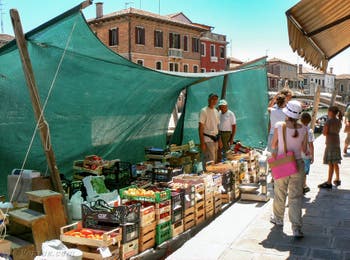
Fruit and vegetable boat in Murano
“Our swinging gondola skirted and turned the wall that closes Murano.
On these shallow, pale waters, which sometimes show the excessive colours of autumn flowers, we followed a channel between beacons, while here and there a poorly dissolved silt outcropped.
A sail, violently coloured ochre, cut off the shimmering air and the solitude of the plain.
These vast liquid spaces, which, towards the north, border the city of the Doges, are as sad as the Roman countryside: the artist and the philosopher like to weigh this desolation almost palpable and heavy as true beauty.”
Maurice Barrès - Amori et Dolori Sacrum - The Death of Venice 1916
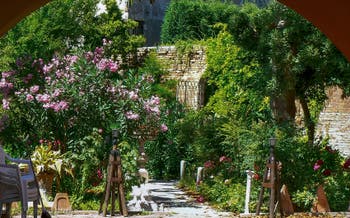
Gardens and oleanders
Bushes of orange, jasmine and pomegranate trees
“A little further on, half an hour by gondola from the Piazzetta, is the famous Murano, where Venetian painting was born, and where the industry and where the glass industry once flourished.
This island had up to 30,000 inhabitants and sixteen churches. One of them, San Donato, is a Byzantine basilica where the influence of Arab art can already be seen.
Another, San Pietro Martyr, is a late fifteenth-century building with paintings by Giovanni Bellini and Veronese.
Glass Museum Garden It is said that Murano, along with Giudecca and the Lido, was once a kind of Armide's garden.
The Italians told of its wonders, and a poet from Feltre, Castaldi, sang of it lyrically in his verses.
Its groves of orange, jasmine and pomegranate trees, whose perfumes scented the lagoon, were, in the 15th century, the favourite rendezvous of friends of Aldo Manuce and the humanists who fled the hassles of the city there.
The viveurs of Venice would also go there for late-night suppers to the sound of music.
Jules Gourdault - Venice and the Veneto 1886
Amidst the flowers of the Orient
Basilica Santi Maria e Donato “Murano. All foreigners visit its glassworks, and poets commemorate the delights of its gardens, famous throughout Europe before the Republic conquered Padua and the great lords populated Brenta.
It was here that, amidst the flowers of the East, which the night made more fragrant, and while the wave swayed the gondolas to the shore, the voluptuous, discreet lovers and politicians came to linger under the mask.”
Maurice Barrès - Amori et Dolori Sacrum - The Death of Venice 1916
More gardens than Venice
“Murano is one of the largest and most pleasant islands in the lagoons, just a short mile from Venice.
The Rio dei Vetrai in Murano There are some beautiful houses and many more gardens proportionately than in Venice.
This island is also crossed by a canal that is larger than the other canals on the same island, and the famous Glassworks that you have heard so much about, are on this canal.
You should not think of these buildings as having anything at all extraordinary; they are divided into several dwellings, rooms, shops, furnaces and pyres, just like everywhere else.
In the past, the glass that is called Venetian crystal, was the most beautiful in Europe.”
Maximilien Misson - Journey to Italy 1720
Isle of Gardens and Pleasures
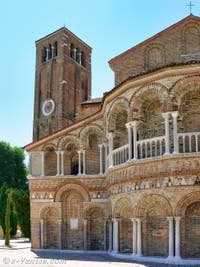
Campanile and church
“His mind wandered through the red and green island of Murano, all blooming with those hyaline flowers in the desolate poverty that made him lose even the memory of the happy time when the poets sang of it as "a sojourn of nymphs and demigods".
He thought of the illustrious gardens where Andrea Navagero, Cardinal Bembo, the Aretinian, Alde (Aldo Manuzio) and the learned choir competed with elegance in their Platonic dialogues, lauri sub umbra.
He thought of monasteries as voluptuous as gynaecae, inhabited by little nuns dressed in white camelot and lace, their foreheads adorned with curls, their breasts uncovered according to the custom of honest courtesans, devoted to secret love affairs, much sought after by licentious patricians, named with sweet names like Ancilla Soranzo, Cipriana Morosini, Zanetta Balbi, Béatrice Falier, Eugenia Muschiera, pious mistresses of lasciviousness.”
Gabriele d'Annunzio - The Fire
Visits Doge's | St.Mark | Gourmets | Museums | Venice | Murano Burano | Gondola | Cruises
Back to Top of Page


